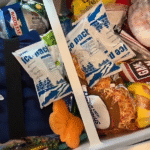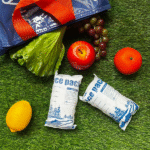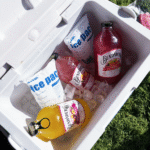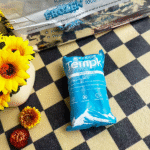Introduction
Maintaining precise temperatures during transport is the heart of successful cold chain logistics. Cooling systems with dry ice pack sheets deliver consistent, températures ultra basses qui protègent les denrées périssables, vaccins, et les produits biologiques contre la détérioration. Dans ce guide, vous découvrirez comment ces feuilles innovantes améliorent le contrôle de la température, Améliorer l'efficacité opérationnelle, et soutenons une logistique durable, tout en respectant les dernières normes industrielles de 2025..
-
Comment les feuilles de glace carbonique améliorent-elles la stabilité de la température pendant le transport?
-
Quelles mesures de sécurité sont essentielles lors de la manipulation de feuilles de glace carbonique?
-
Comment les entreprises peuvent-elles intégrer efficacement les systèmes de refroidissement?
-
Quelles sont les considérations environnementales et réglementaires?
-
Quelles sont les dernières 2025 les tendances de la chaîne du froid, moteurs de l'innovation?
Comment les feuilles de glace carbonique maintiennent-elles le contrôle de la température pendant le transport?
Les feuilles de glace carbonique maintiennent des conditions inférieures à zéro sans fondre ni accumulation d'humidité., garantir que les produits restent secs, froid, et en toute sécurité. Contrairement à la glace ordinaire, ce qui ajoute de l'humidité indésirable, la neige carbonique se sublime directement en gaz CO₂ — maintenant un froid constant tout en éliminant la condensation.
Cela les rend idéaux pour médicaments, fruit de mer, et aliments surgelés that must remain below critical temperature thresholds. By customizing the quantity and insulation type, businesses can preserve product integrity throughout long-distance shipments.
Meilleures pratiques pour le contrôle de la température
| Méthode d'emballage | Type d'isolation | Durée prévue | Bénéficier à vous |
|---|---|---|---|
| Styrofoam container | Haut | Jusqu'à 48 heures | Maintains premium freshness for long routes |
| Insulated cardboard box | Moyen | 24 heures | Practical for local or same-day delivery |
| Vacuum-insulated panel | Supérieur | 72 heures + | Ideal for pharmaceuticals and long export hauls |
Conseil: Always monitor internal temperatures with IoT sensors or data loggers to verify compliance during transit.
Exemple concret: A seafood exporter used multi-layer dry ice pack sheets with Styrofoam boxes and achieved a 40% reduction in spoilage, maintaining product quality over a 48-hour air route.
What Safety Measures Are Required When Using Dry Ice Pack Sheets?
Safety is crucial when handling dry ice, as it sublimates into CO₂ gas, which can displace oxygen in enclosed areas. Always ensure proper ventilation and use vented containers to release built-up gas. Le contact direct avec de la neige carbonique peut provoquer des engelures, so insulated gloves are mandatory.
Safety Guidelines at a Glance
| Safety Step | Description | Pourquoi ça compte |
|---|---|---|
| Ventilation | Work in well-ventilated spaces | Empêcher l'accumulation de CO₂ |
| Protection personnelle | Use insulated gloves and face shields | Avoid cold burns |
| Étiquetage approprié | Mark as “Dry Ice – UN 1845” | Ensure compliance with IATA/DOT transport rules |
Conseils supplémentaires:
-
Ne scellez jamais de glace carbonique dans des contenants hermétiques.
-
Train all logistics staff on emergency response and hazard labeling.
-
Include Material Safety Data Sheets (FDS) with every shipment.
How Do Dry Ice Pack Sheets Enhance Supply Chain Efficiency?
Feuilles de glace carbonique streamline operations by offering lightweight, residue-free cooling that requires minimal maintenance. Their flexibility and scalability enable use across diverse cargo sizes — from meal kits to medical samples.
Key Advantages for Cold Chain Operations:
-
Poids réduit: Lighter than gel packs or water ice, lowering freight costs.
-
Durée plus longue: Maintains cold up to 72 hours depending on insulation.
-
Utilisation polyvalente: Couper, pli, or stack to match any package size.
-
Cleaner Process: No water residue or mold risk.
Aperçu du cas: A biotech firm shipping RNA samples replaced gel packs with dry ice pack sheets and cut costs by 22% while meeting WHO temperature compliance.
What Are the Environmental and Regulatory Considerations?
While dry ice itself is made from CO₂, c'est environmental footprint can be minimized by using sources captured from industrial emissions — turning waste carbon into a valuable refrigerant. Many suppliers now offer carbon-neutral dry ice solutions.
Sustainability and Compliance Overview
| Facteur | Description | Avantage |
|---|---|---|
| Captured CO₂ production | Made from recycled industrial gas | Reduces net emissions |
| Emballage réutilisable | Insulated boxes or PCM hybrid systems | Minimizes waste |
| Regulatory standards | Iata / POINT / CRB / SQF certified logistics | Ensures global compliance |
Conseil: Combine dry ice with reusable PCM panels to achieve hybrid cooling that balances sustainability and performance.
How Can Companies Implement Cooling Systems with Dry Ice Pack Sheets Effectively?
Implementing these systems requires evaluating shipment type, itinéraire, et température ambiante. Start with a pilot test to determine optimal insulation thickness and sheet quantity.
Implementation Checklist
-
Assess Transport Conditions: Déterminer la plage de température, cargo sensitivity, et durée du transit.
-
Former le personnel: Focus on handling, ventilation, et conformité réglementaire.
-
Integrate IoT Sensors: Enable real-time monitoring and predictive alerts.
-
Collaborate with Specialists: Partner with certified cold chain providers for tailored setups.
Exemple pratique: A regional vaccine distributor introduced IoT-enabled dry ice logistics and achieved 99.8% conformité de la température à travers 200 deliveries in 2025.
2025 Tendances et innovations de la chaîne du froid
The cold chain industry is evolving toward intelligent, durable, and automated solutions. Dans 2025, several major trends are reshaping how companies use dry ice cooling systems.
Technologies émergentes
-
IoT and AI Integration: Real-time temperature and humidity tracking with automated alerts.
-
Traçabilité de la blockchain: Transparent shipment histories for pharmaceutical compliance.
-
Eco-Efficient Manufacturing: Dry ice made from captured CO₂ and powered by renewable energy.
-
Systèmes de refroidissement hybrides: Combining PCMs with dry ice for extended duration and reusability.
Perspicacité du marché (2025):
The global cold chain market reached USD 418 milliard and is forecasted to exceed USD 1.4 mille milliards par 2034 (TCAC ≈ 14.5%). Sustainable cooling systems and smart monitoring are driving this exponential growth.
Questions fréquemment posées
Q1: Combien de temps durent les feuilles de glace sèche?
Typically 24–72 hours depending on insulation quality, quantité, et température ambiante.
Q2: Les feuilles de glace carbonique sont-elles réutilisables?
Most are single-use, but hybrid PCM models allow multiple cycles for moderate cooling ranges.
Q3: Is it safe to ship food with dry ice pack sheets?
Oui, as long as vented packaging and proper labeling are used to release CO₂ gas safely.
Q4: How should I dispose of used sheets?
Let remaining CO₂ fully dissipate in a ventilated space, then recycle packaging according to local guidelines.
Résumé et recommandations
Cooling systems with dry ice pack sheets are transforming cold chain logistics by providing ultralow temperatures, cleaner operation, and scalable performance. To maximize benefits:
-
Choose eco-friendly dry ice from captured CO₂ sources.
-
Equip shipments with real-time monitoring sensors.
-
Train personnel in safety and regulatory compliance.
-
Explore hybrid cooling for long-duration deliveries.
Étapes suivantes
-
Audit your current cold chain operations.
-
Select the right dry ice pack sheet configuration for your cargo and route.
-
Adopt smart monitoring tools for full shipment transparency.
-
Partner with certified cold chain experts to optimize cost and compliance.
À propos du tempk
Rotation specializes in next-generation cold chain solutions built for efficiency, sécurité, et durabilité. Notre cooling systems with dry ice pack sheets deliver consistent temperature performance for pharmaceuticals, aliments, et les biologiques. With decades of expertise and a commitment to innovation, nous vous aidons à expédier plus intelligemment, plus sûr, et plus vert.
Appel à l'action:
Contact Tempk today to design a custom cold chain solution that protects your products and enhances your logistics performance.























